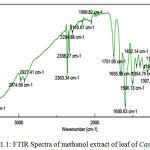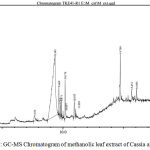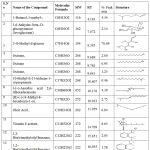Department of Zoology, Thiruvalluvar University, Serkadu, Vellore-632115, Tamilnadu, India.
DOI : https://dx.doi.org/10.13005/bpj/1355
Abstract
The methanolic extract of plant Cassia alata was prepared by using soxhlet apparatus. FTIR and GCMS analysis were done to this plant extract to find out the bioactive phytocompounds. The FTIR results of this plant extract showed 21 peaks indicate the presence of the bioactive compounds such as sulfates, sulfonamides, sulfones, sulfonyl chlorides, sulfates, sulfonamides, alkanes, aromatic, aromatic, alkenes, ester, alkenes, ketenes, isocyanates, isothiocyanates, acetylene, nitrile, phosphine, phosphine, aldehyde, alkane, amide, alcohol and alcohol. The GCMS results showed 13 peaks. The retention time (RT) of all these thirteen peaks indicate the presence of functional group such as 1-Butanol, 3-methyl-1,6-Anhydro-.beta.-D-glucopyranose (levoglucosan), 3-O-Methyl-d-glucose, Oxirane, 10-Methyl-E-11-tridecen-1-ol propionate, l-(+)-Ascorbic acid 2,6-dihexadecanoate, (R)-(-)-14-Methyl-8-hexadecyn-1-ol, Oleic Acid , Vitamin E acetate and 1,2-Bis(trimethylsilyl) benzene.
Keywords
Bioactive Phytocompounds; Cassia Alata; Functional Groups and Soxhletion Methanolic Extract;
Download this article as:| Copy the following to cite this article: Kavipriya K, Chandran M. FTIR and GCMS Analysis of Bioactive Phytocompounds in Methonalic Leaf Extract of Cassia Alata. Biomed Pharmacol J 2018;11(1). |
| Copy the following to cite this URL: Kavipriya K, Chandran M. FTIR and GCMS Analysis of Bioactive Phytocompounds in Methonalic Leaf Extract of Cassia Alata. Biomed Pharmacol J 2018;11(1). Available from: http://biomedpharmajournal.org/?p=18736 |
Introduction
Plants play a vital role in our lives. Addition to this, they are mainly used to cure the various human diseases, treatment of ailment and improve the health of affected organs from the period of time immemorial (Sofowora,1993). About 80% of the world’s population relies solely or largely on traditional remedies for their healthcare needs. Today, about 70,000 to 80,000 plant species are used for medicinal or aromatic purposes globally. This is because of some biological active and naturally occurring phyto-chemical present in the various parts of plants. Plant produce these chemical compounds as part of their normal metabolic activities to protects their own cells from environmental hazards such as pollution, stress, drought, UV exposure and pathogenic attack (Gibson et al., 1998., Mathai et al., 2000 and Izhaki, 2002 ), which provide health benefits for humans further than those attributed to macronutrients and micronutrients (Hasler and Blumberg, 1999). Even today, large number of peoples in the developing countries are using the plants and plant based preparations to cure various diseases by their inherent traditional knowledge because of they believe the herbal medicines are safer than synthetic medicines because the phytochemicals in the plant extract target the biochemical pathway (Zaidan et al., 2005). Addition to this, the side effects associated with synthetic drugs continue to make researchers to look for natural remedies which are safe and effective (Gijtenbeek et a., 1999 and Johnson and William, 2002). A single plant may contain a great number of bioactive phytocompounds and a combination of plants even more. This complexity is one of the most important challenges to phytoscientists to identify and sort out which bioactive compounds has the potential to cure which disease. Without screening the active compounds from particular plant, the researcher cannot invent a new medicinal drug to cure particular disease. Hence, in the present investigation, the plant Cassia alata have been selected to screen the possible bioactive compounds by GCMS method.
Plant Description
Cassia alata belongs to family Fabacea and sub family Caesalpinioideae is commonly known as King of the forest, emperor’s candlesticks, candle bush, candelabra bush, Christmas, Ringworm Bush, Dadrughna, Dadmardan, Dadmari (Daad=Ringworm) Desay, Fleur, Impetigo bush, Ringworm tree, Candelabra bush, Guajava Empress candle plant, Seven Golden Candlestick, and Christmas candle. It is a medium growing, soft wooded medicinal shrub plant reaching up to height of 6-8 feet. This plant is growing in open wastelands near watery places. It is one of the oldest known medicinal plant of Central America, worldwide, particularly in Asia Pacifi countries where people used it for curing skin diseases, worms, fever, bites of insects, ring worm, goiter, hook worm infestation, sexually transmitted diseases, constipation and other skin diseases ,blemishes, scabies, ringworm and other fungal skin infections.
Common Names in Various Countries
Dadmurdan (Hindi), Seemaiagathi (Tamil), Simayakatti (Malayalam,), Aaku pero (Busk Iland), Akapulko (Philippines), Akapulko (West Africa), Akoria (West Africa), Awunwon (West Africa), Ayengogo (Guinea),Bai nicagi (Guinea), Bakua (Guinea), Balilang (Malaysia), Barajo (Guatemala), Candlebra bush (Thailand), Candle tree (Malaysia), Christmas blossom (Nicaragua), Chumhet yai (Thailand), Dadmaran (India), Cortalinde (Guinea –Bissau), Dadmurdan (Fiji), Dadrughna (India), Galinggang hutan (Indonesia), Gelenggang (Malaysia), Gelenggang (Indonesia),Grili (Papua New Guinea), Kabaiura-(Paua New Guinea), Ketapeng(Indonesia), King of the Forest (Jamaica), Kinkeliba (Gabon), Kislin ( Nicaragua)La au fai lafa (Nicaragua), Maliof (Papua-New guinea), Mata pasto (Brazil), Mhingu (Tanzania), Mongrang-jangtong (India), Mulu mula(India), Mulu mulu (Papua), Njepaa (Sierra Leone), Okpo Ndichi (Sierra Leone), Palotsina (Philippines), Pui-chi (Bangladesh), Qanabisi (Nicaragua), Ringworm bush (Fiji, Guyana, West India),Ringworm cassia (Malaysia), Roman candle tree (Fiji), Sengseng (India), Serocontil (Nicargua), Sindjo-el (Guinea-Bissau), Sussaika (Nicaragua), Sustara saika (Nicarague), Suswaha tara (Nicarague), Tarantan (west indies), Telelango (West indies), Totoncaxihuitl (Mexico), Wasemu (Papau),Wild senna (West indies).
Cassification
Kingdom: Plantae
Order: Fabales
Family: Fabaceae
Subfamily: Caesalpinioideae
Tribe: Cassieae
Subtribe: Cassiinae
Genus: Senna
Species: Senna alata
Distribution
This plant is mostly found in tropic and sub-tropical regions. i.e., India, Pakisthan, Burma, Srilanka, Philliphines and most of the African countries.
Habitats
They are grow as open vegetation in roadsides, river banks, rain forest edges, lake shores, pond and ditch margins, open forest, orchards and around villages, at elevations up to 1,400 metres, and fast-growing, but short-lived plant. This plant is mostly found in moister areas in the tropics. It is reported to tolerate a mean annual rainfall of 600 – 4,300mm and average yearly temperatures of 15 – 30°C, grow well in well drained both heavy and sandy, acid to slightly alkaline, soil of a sunny position, wastelands, flood plains, highly adaptable, tolerating both drought and waterlogged soils.
Morphology
This plant is erect shrub, able to grow up to 3 – 4 m tall. Foliage contains pinnately compound leaves with 6 – 12 pairs of leaflets (30 – 60 cm long). Leaflets are oblong, smooth and thinly leathery (6 – 15 cm long, 3.5 – 7.5 cm wide) in appearance. They have a rounded tip with a slight indentation in the middle. The flowers are arranged in a vertical column and bloom from the base of the column. The inflorescence is raceme type, resembles a lit, yellow candle, because the flowers at the base are yellow, while the unopened flower buds at the top are covered by orange bracts. Fruits are in the form of winged pods with dark purple to black colour, smooth and 4-sided. Each pod contain 50 – 60 flattened, triangular to squarish seeds.
Medicinal uses
In rural Tamilnadu, this plant is used to treat various skin diseases caused by bacteria and fungal infection and by insect bite. Cassia alata is widely used as traditional medicine in India and Southeast Asia (Reezal et al., 2002). This plant is reported to possess insecticidal, anti-inflammatory, hydragogue, sudorific, diuretic, pesticidal properties.Fresh leaves juice is used for ring worm, snakebite, scorpion bite, skin diseases, impetigo, syphilis sores,itching, mycosis (washerman’s itch), herpes and eczema. Roots, leaves and flowers of this plant possess many biological properties such as antibacterial, antifungal, anti-inflammatory, antitumor, expectorant and also useful in urinary tract problems (Quattrocchi, 2012), The leaves have been reported to be useful in the treatment of convulsions, gonorrhoea, heart failure, abdominal pains, oedema.
Materials and Method
Fresh leaves of Cassia alata were collected from in and around Thiruvalluvar University campus and shade dried. These Shade dried leaves were ground well by using mixer grinder to get fine powder. This powder was stored in a air tight contained for later usage. 25 grams of this powder was packed in the thimble of the soxhlet extractor and the methanol was loaded into the distillation flask. The leaf extract obtained at the flask finally collected after the completion of soxhlation. This methanol extract was taken to the FTIR and GCMS analysis.
FTIR and GCMS Analysis
FTIR analysis was done by the instrument FT/IR-6300 type, S.No-A021261024 BMDLABS Company in standard light sources by using TGS detector at resolution 4cm-1. The GCMS analysis was done by GCMS- Perkin Elmer.
The bioactive compound of methanol extract of leaves of plant Cassia alata was traced out by FTIR spectrophotometer (Thermo electron Scientific). Totally 21 peaks were obtained for the FTIR analysis of Cassia alata methanol extract. The IR spectrum of Cassia alata sample showed an absorption band at 564.08 cm-1 which corresponds to C-Cl stretching showed the presence of alkyl halides, band at 807.06 cm-1 is C-H stretching exhibit the presence of, aromatic, bands at 1167.69 cm-1,1199.51 cm-1,1307.50 cm-1,1354.75 cm-1,1452.14 cm-1,1506.13 cm-1,1600.63 cm-1,1655.59 cm-1,1751.05cm-1,1999.82cm-1,2165.67 cm-1,2294.88 cm-1,2338.27 cm-1,2363.34 cm-1,2927.41 cm-1,2974.66 cm-1,3332.39 cm-1,3726.76 cm-1 and 3823.19 cm-1 indicate the presence of bioactive compounds such as sulfones, sulfonyl, chlorides, sulfates, sulfonamides, sulfones, sulfonyl chlorides, sulfates, sulfonamides, alkanes, aromatic, aromatic, alkenes, ester, alkenes, ketenes, isocyanates, isothiocyanates, acetylene, nitrile, phosphine, phosphine, aldehyde, alkane, amide, alcohol and alcohol.
GC-MS chromatogram of the ethanol leaf extract of Cassia alata (Figure 2) showed 13 peaks indicating the presence of thirteen compounds with the retention time range between 2.72 and 34.54 (Figure 2).The active principles in the methanol leaf extract of Cassia alata were confirmed based on retention time (RT), molecular formula, molecular weight (MW) and structures. The phytochemical compounds with their retention time (RT), molecular formula, molecular weight (MW) and structures are presented in Table 3. The first compound identified with less retention time (4.181min) was 1-Butanol, 3-methyl-, whereas 1,2-is(trimethylsilyl)benzene, was the last compound which took longest retention time (16.055min) to identify. The phyto chemicals identified through GC-MS analysis of methanol leaf extract of Cassia alata.
The present GC-MS analysis result of C. alata leaves all thirteen compounds possess many biological properties. For instance, Oleic acid shows some beneficial effect on cancer, autoimmune and inflammatory diseases, besides its ability to facilitate wound healing and may improve the immune response associated to a more successful elimination of pathogens such as bacteria and fungi, by interfering in many components of immune system such as macrophages, lymphocytes and neutrophils ( Sales-Campos et al, 2013).Vitamine E acetate at retention time 14.709 (RT) is a potent antioxidant compound. It exhibits antioxidant activity by virtue of the phenolic hydrogen on the 2H-1-benzopyran-6-ol nucleus. It has four methyl groups on the 6-chromanol nucleus. The natural d- form of alpha-tocopherol is more active than its synthetic dl-alpha-tocopherol racemic mixture. 10-Methyl-E-11-tridecen-1-ol propionate obtained at retention time 10.607(RT) was also identified in GSMS study of Premna serratifolia by Vasantha and Maruthasalam (2015) has no any remarkable bioactivity. l-(+)-Ascorbic acid 2,6-dihexadecanoate observed at retention time 10.176 (RT) shows Antioxidant, antiscorbutic, antiinflammatory, antinociceptive, anti- mutagenic, wound healing property ( Vasthi Gnana Rani and Murugaiah, 2015). The bioactive compound oxirane observed at retention time 9.669,9.783 and 9.841 exhibited bacticidal fungicidal and sporicidal activities. Its is also used as effective antimicrobial agent to control a variety of micro organisms including virus and also used as sterilizing agent (Pub-chem,2004). ,6-Anhydrohexopyranoses observed at 7.672min have proven to be valuable synthons for the preparation of biologically important and structurally diverse products such as rifamycin S, indanomycin, thromboxane B2, (+)-biotin, tetrodotoxin, quinone, macrolide antibiotics and modified sugars. phytocompound 1,2-Bis(trimethylsilyl)benzene at retention time15.651 and 16.055 min has antioxidant, antimicrobial, anticanserous and antitumerous activity (Alok prakash and Suneetha,2014)
 |
Figure 1.1: FTIR Spectra of methanol extract of leaf of Cassia alata
|
Table 1.1: Peak values, band type and functional group for FTIR Spectra of methanol leaf extract of Cassia alata
| S.No | Frequency (cm-1) | Types of compound | Bond responsible | Intensity |
| 1 | 564.08 | Alkyl halides | C-Cl or C-Br C-H | Strong |
| 2 | 807.06 | Aromatic | S=O | Strong |
| 3 | 1167.69 | Sulfones, Sulfonyl Chlorides, Sulfates, Sulfonamides | ||
| Sulfones, Sulfonyl Chlorides, Sulfates, Sulfonamides | S=O | |||
| 4 | 1199.51 | Alkanes | Strong | |
| Aromatic | ||||
| 5 | 1307.5 | Aromatic | C-H | Strong |
| 6 | 1354.75 | Alkenes | C=C | Strong |
| 7 | 1452.14 | Ester | C=C | Medium to weak |
| 8 | 1506.13 | Allenes, Ketenes, Isocyanates, Isothiocyanates | C-C | Medium to weak |
| 9 | 1600.63 | Acetylene, nitrile | C-O | Variable two bonds |
| 10 | 1655.59 | Phosphine | X=C=Y | Strong |
| Phosphine | ||||
| 11 | 1751.05 | C=N, C=C | Medium to Strong | |
| Aldehyde, | ||||
| 12 | 1999.82 | Alkane | P-H | Strong |
| Amide | ||||
| 13 | 2165.67 | Alkanes | P-H | Medium |
| Alkanes | ||||
| 14 | 2294.88 | Carboxylic acids | C-H | Medium |
| Alcohol | ||||
| 15 | 2338.27 | Alcohol | C-H | Weak |
| 16 | 2363.34 | N-H | Medium to strong | |
| 17 | 2927.41 | C-H | strong | |
| 18 | 2974.66 | C-H | Strong | |
| 19 | 3332.39 | O-H | Medium | |
| 20 | 3726.76 | O-H | Strong and broad | |
| 21 | 3823.19 | O-H | Strong and broad |
 |
Figure 1.2: GC-MS Chromatogram of methanolic leaf extract of Cassia alata
|
 |
Table 1.2: Bioactive compounds identified in the methanol leaf extract of Cassia alata
|
References
- Prakash A and SuneethaV . Punica granatum (Pomegranate) Rind Extract as a Potent Substitute for L. Ascorbic Acid With respect To the Antioxidant Activity. Research Journal of Pharmaceutical, Biological and Chemical Sciences. 2014;597.
- Gibson E.L, Wardel J and Watts C.J. Fruit and Vegetable Consumption, Nutritional Knowledge and Beliefs in Mothers and Children. Appetite. 1998;31:205-228.
CrossRef - Gijtenbeek J.M.M, Bent V.M.J and Vent C.J. Cyclosporine neurotoxicity. Journal of Neurology. 1999;246: 339–346.
CrossRef - Izhaki I. The role of fruit traits in determining fruit removal in East Mediterranean ecosystems. In: Levey DJ, Silva WR, Galetti M, eds. Dispersal and frugivory: ecology, evolution and conservation. Wallingford, UK: CAB International Publishing. 2002;161–175.
CrossRef - Hasler C.M and Blumberg J.B. Symposium on Phytochemicals: Biochemistry and Physiology. Journal of Nutrition. 1999;129:756S-757S.
CrossRef - Johnson W.C and William O.W. Warfarin toxicity. Journal of Vascular Surgery. 2002;35:413-421.
CrossRef - Maruthasalam A and Vasantha K. Identification of bioactive compounds from ethanolic leaf extracts of Premnaser ratifolia unsing GC-MS rency RC1. Bioscience discovery. 2015;6(2):96-101.
- Mathai K. Nutrition in the Adult Years. In Krause’s Food, Nutrition, and Diet Therapy, 10th ed., ed. L.K. Mahan and S. Escott-Stump, American Cancer Society. 2000.
- Ogunti E.O and Elujobi A.A. Laxative activity of Cassia alata. Fitoterapia. 1993;64:437-439.
- Owoyale J.A, Olatunji G.A and Oguntoye S.O. Antifungal and Antibacterial Activities of an Alcoholic Extract of Senna alata. Journal of Applied Science and Environment. 2005;9:105-107.
- Quattrocchi U. C R C World Dictionary of Medicinal and Poisonous plants.CRC press, BocoRoton. 2012.
- Reezal I, Somchit M.N and Rahim M.A. Invitro antifungal properties of Cassia alata (Gelenggang Besar). Proceedings of the Regional symposium on Environment and Natural Resources, Hotel Renaissance Kulalampur, Malasiya. 654-659.
- Sales-campos H, Souza P.R, Peghini B.C, Da silva J.S and CardosoC.R. An overview of the modulatory effects of oleic acid in health and disease. Mini rev med chem. 13(2):201-10.
- A . Medicinal Plants and Traditional Medicine in Africa. Spectrum Books Ltd., Ibadan, Nigeria. 1993;191-289.
- Gnana V .R and Murugaiah. GC-MS determination of bioactive compounds in Azimatetra cantha. World journal of pharmaceutical research. 2015;4(06)2225- 2231.
- Williams J.B. The plagiarism problem: Are students entirely to blame? Proceedings 19th ASCILITE . 2002;2: 721-30.
- Zaidan M, Rain N and Badrul A. In vitro screening of five local medicinal plants for antibacterial activity using disc diffusion method.Trop. Biomed. 2005;22:165-170.









